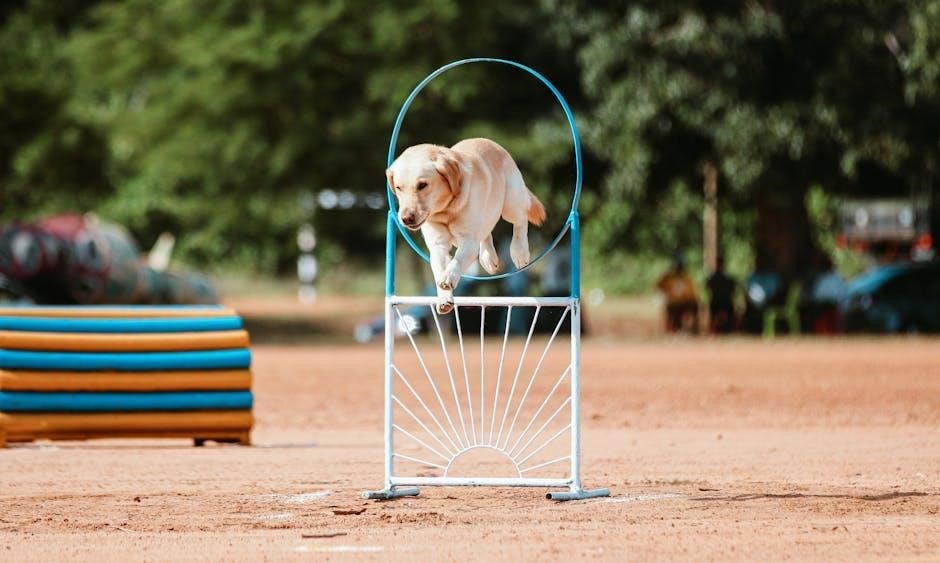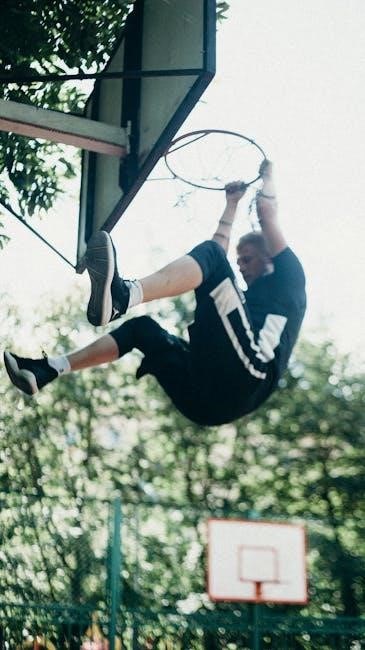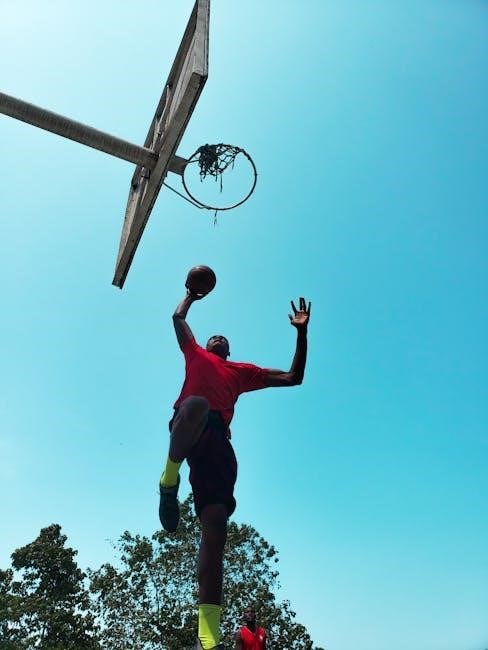Jump rings are essential in jewelry making, connecting components securely. This guide explains sizing, measurement, and selection for wire wrapping, chainmaille, and beading projects.

Understanding the Importance of Jump Ring Sizes
Accurate jump ring sizing is crucial for jewelry making, as it ensures structural integrity and aesthetic appeal. Properly sized jump rings prevent pieces from being too tight or loose, maintaining durability and visual balance. For wire wrapping, chainmaille, and beading, the right size ensures secure connections without compromising flexibility. Incorrect sizing can lead to weak links or poor fit, undermining the overall design. Understanding size requirements helps in selecting appropriate materials and techniques, ensuring professional-quality results in various jewelry-making projects.
Components of a Jump Ring
A jump ring consists of an inside diameter, wire thickness, and opening. The wire thickness is measured in gauges (e.g., 16ga) or millimeters, crucial for jewelry projects.
Inside Diameter vs. Wire Thickness
Inside diameter measures the hole’s size, while wire thickness refers to the metal’s gauge. Both are crucial for jewelry making. Thicker wire (e.g., 16ga) is stronger but harder to shape, while thinner wire (e.g., 20ga) is more flexible. The inside diameter must accommodate beads or wires without being too loose or tight. A common ratio is 2:1 for the inside diameter relative to the wire’s diameter. For example, an 18ga wire typically uses a 4mm inside diameter. Balancing these ensures functionality and aesthetics in chainmaille, wire wrapping, or beading projects. Accurate measurement and material matching are key for professional results.
Opening Size and Its Significance
The opening size of a jump ring determines how easily it can be closed or opened. A larger opening provides easier access but may compromise security, while a smaller opening offers better protection against unintended opening. The opening size is influenced by the wire thickness and inside diameter. For example, a thicker wire gauge (e.g., 16ga) typically results in a smaller opening compared to a thinner wire (e.g., 20ga). Proper sizing ensures the jump ring is functional for its intended use, whether for wire wrapping, chainmaille, or beading. Measuring tools like calipers or gauges help achieve precise results for secure connections.


Measuring Jump Rings
Measure jump rings using calipers or rulers for accuracy. Digital tools ensure precision, helping determine inside diameter and wire thickness for proper sizing and secure connections.

Using a Ruler or Calipers
Measuring jump rings accurately is crucial for jewelry projects. Use a ruler or calipers to determine the inside diameter, the primary measurement for sizing. For precise results, calipers are recommended, especially for wire thickness. Measure the gap carefully to ensure secure connections and proper fit. This method ensures accuracy for various applications, from wire wrapping to chainmaille. By understanding how to measure correctly, you can avoid common sizing errors and achieve professional-quality results in your designs.
Digital Tools for Precision
Digital tools like calipers and ring size apps offer precise measurements for jump rings. Apps provide accurate size conversions, while digital calipers ensure exact readings. These tools are especially useful for consistent sizing and professional results. They simplify the process, reducing errors and saving time for jewelers and crafters. By utilizing digital tools, you can achieve precise measurements and ensure your jump rings fit perfectly in your designs, enhancing both functionality and aesthetics in your jewelry-making projects.

Choosing the Right Jump Ring Size
Choosing the right jump ring size involves considering wire thickness, desired durability, and design needs. Proper sizing ensures secure connections and professional-looking jewelry pieces.
For Wire Wrapping Projects
For wire wrapping projects, selecting the right jump ring size is crucial for securing beads and maintaining design integrity. The jump ring’s inner diameter should accommodate the wire gauge used, ensuring easy wrapping without compromising strength. A common ratio is 1:2.1, where the inner diameter is 2.1 times the wire’s thickness. Using a mandrel can help achieve precise sizing. Proper sizing ensures the jump ring holds securely, preventing gaps or overly tight wraps. Match the jump ring size to your wire gauge for a professional finish and long-lasting durability in your wire-wrapped jewelry designs.

For Chainmaille and Weaving
In chainmaille and weaving, jump ring size is critical for achieving the desired pattern and structural integrity. The inner diameter must align with the wire gauge to ensure proper interlocking of rings. A common ratio is 1:2.1, where the inner diameter is 2.1 times the wire’s thickness. For example, 16ga wire pairs well with a 4mm inner diameter. Using oversized rings can result in a loose weave, while undersized rings may restrict movement. Selecting the right size ensures a balanced, flexible, and visually appealing design. Always test the fit by interlocking a few rings before committing to a large project.
For Beading and Stringing
When using jump rings for beading and stringing, the size must accommodate the beads and stringing material. The inner diameter should be slightly larger than the beads to allow easy threading without compromising security. A smaller wire gauge (thicker wire) provides durability, while a larger gauge (thinner wire) is better for delicate designs. For most beading projects, a 6mm to 8mm inner diameter with an 18-20 gauge wire is ideal. Ensure the jump ring’s opening is large enough for the stringing material but not so big that it compromises the bead’s stability. Proper sizing ensures a secure and balanced piece of jewelry.

Jump Ring Size Chart
A standard size chart helps match inner diameter, wire gauge, and opening size for various projects, ensuring the right fit for jewelry making and crafting needs.
Standard Size Chart
A standard jump ring size chart typically includes measurements for inner diameter, wire thickness, and opening size. Common gauges range from 14ga to 24ga, with diameters from 2mm to 10mm. Wire thickness is crucial for durability, while inner diameter affects compatibility with beads or chains. For example, a 6mm inner diameter with 18ga wire is ideal for medium-weight projects. Always compare your needs with the chart to ensure the right balance between strength and flexibility for successful jewelry making or crafting.
Common Mistakes to Avoid
Common mistakes include incorrect measurement, using improper tools, and ignoring wire thickness, leading to insecure connections or damaged jewelry. Precision is key for reliable results.
Mistakes in Measuring and Sizing
One of the most common errors is using improper tools, such as a standard ruler, which can lead to inaccurate measurements. Additionally, neglecting to account for wire thickness often results in ill-fitting connections. Many jewelers also overlook the importance of matching the jump ring size to the project’s specific requirements, causing structural instability. Incorrect sizing can compromise the durability and security of the piece, making it prone to opening or breaking. To avoid these issues, use precision tools like calipers and always refer to a reliable size chart for accurate measurements.
Proper sizing and precision are key to successful jewelry making with jump rings. Avoiding common mistakes ensures durability and security in your designs.

Final Tips for Working with Jump Rings
Always prioritize precision when measuring and selecting jump rings to ensure secure connections. Invest in quality tools like calipers for accurate sizing. When closing jump rings, use flat-nose pliers to avoid gaps. For longevity, choose rings made from durable materials like stainless steel or titanium. Test the ring’s opening and closing mechanism before use. Store jump rings in an organized manner, categorizing them by size to save time during projects. Finally, practice makes perfect—mastering the technique ensures professional-looking results in jewelry making and crafting.
